2007 Exhibitions and Events
Jamie Owen
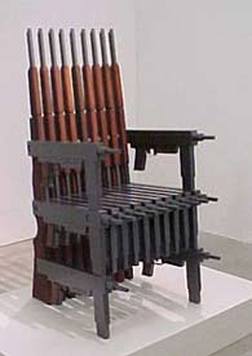
01.015.07
Decorating The Gun Lobby
Selected Works
January 5 - 20, 2007
Opening Reception: Friday, Jan 5th
"Looking at violence as a methodology for building awareness is an ironic approach to peace. It's also dubious subject matter for artists to toy with. Jamie Owen, as he pointedly illustrates in Decorating the Gun Lobby is the Michael Moore of artists. Bowling for Columbine has nothing on this show.
Owen used to feature excerpts from Michael Moore's documentary on his TV sculpture entitled "Home Entertainment Unit," but realized he was able to convey his desired message just as clearly with the TV off. The piece is a larger than life size pistol sculpture (too large for CRAM!) doubling as a TV stand. The TV rests in the bullet cavity, and the gun compartments open up to expose shelving, making this sculpture a fully functioning entertainment unit that could be marketed and sold in our society. In this exhibition Owen presents his sculptures as furniture.
As a child Owen spent his time making wooden guns and knifes. "As an adult, I continue to make wooden guns," he says. However, when he makes a wooden weapon now it isn't to play good guy/bad guy with his buddies, it's to address some serious issues in our society. "My intent is to stir the viewer to think and perhaps act. I feel an obligation to society to portray issues surrounding pollution and violence. We are killing our planet and each other but we don't take it seriously enough unless it affects us personally."
By making the art functional we are forced to consider the conceptual messages these objects express in an everyday context. If you were to decorate your life with Owen's brand of awareness, you would have a giant gun for a TV stand, a chair made from weapons, baby booties made from bullets, and hand grenades that are candle holders. It's an explosive interior design. "It's a spoof on the medium, the message and the viewer. There is absurdity to these pieces which makes them intriguing, funny, and disturbing all tied into one. I deliver serious messages wrapped in humourous packages. The function of art is to make people look and think about the world around them." According to that definition of art, I would say Owen is a roaring success. Decorating the Gun Lobby grabs your attention and twists your mind to consider things in ridiculous ways, which is exactly the point. "My overall goal is to connect with the viewer to take a closer look at the absurdity of what we do," he says. Point, aim, and shoot, this show hits its target. Owen manages to use symbols of violence to make us reflect on how silly it all is. The irony of violence in this case turns the channel on awareness."
Excerpts from article by
LAURA HOLLICK
DECORATING THE GUN LOBBY
by Jamie Owen
YOU ME GALLERY
View Magazine
Greater Hamilton's Weekly Alternative
Vol. 12 No. 50
December 14-20, 2006
Decorating The Gun Lobby
Selected Works
January 5 - 20, 2007
Opening Reception: Friday, Jan 5th
"Looking at violence as a methodology for building awareness is an ironic approach to peace. It's also dubious subject matter for artists to toy with. Jamie Owen, as he pointedly illustrates in Decorating the Gun Lobby is the Michael Moore of artists. Bowling for Columbine has nothing on this show.
Owen used to feature excerpts from Michael Moore's documentary on his TV sculpture entitled "Home Entertainment Unit," but realized he was able to convey his desired message just as clearly with the TV off. The piece is a larger than life size pistol sculpture (too large for CRAM!) doubling as a TV stand. The TV rests in the bullet cavity, and the gun compartments open up to expose shelving, making this sculpture a fully functioning entertainment unit that could be marketed and sold in our society. In this exhibition Owen presents his sculptures as furniture.
As a child Owen spent his time making wooden guns and knifes. "As an adult, I continue to make wooden guns," he says. However, when he makes a wooden weapon now it isn't to play good guy/bad guy with his buddies, it's to address some serious issues in our society. "My intent is to stir the viewer to think and perhaps act. I feel an obligation to society to portray issues surrounding pollution and violence. We are killing our planet and each other but we don't take it seriously enough unless it affects us personally."
By making the art functional we are forced to consider the conceptual messages these objects express in an everyday context. If you were to decorate your life with Owen's brand of awareness, you would have a giant gun for a TV stand, a chair made from weapons, baby booties made from bullets, and hand grenades that are candle holders. It's an explosive interior design. "It's a spoof on the medium, the message and the viewer. There is absurdity to these pieces which makes them intriguing, funny, and disturbing all tied into one. I deliver serious messages wrapped in humourous packages. The function of art is to make people look and think about the world around them." According to that definition of art, I would say Owen is a roaring success. Decorating the Gun Lobby grabs your attention and twists your mind to consider things in ridiculous ways, which is exactly the point. "My overall goal is to connect with the viewer to take a closer look at the absurdity of what we do," he says. Point, aim, and shoot, this show hits its target. Owen manages to use symbols of violence to make us reflect on how silly it all is. The irony of violence in this case turns the channel on awareness."
Excerpts from article by
LAURA HOLLICK
DECORATING THE GUN LOBBY
by Jamie Owen
YOU ME GALLERY
View Magazine
Greater Hamilton's Weekly Alternative
Vol. 12 No. 50
December 14-20, 2006
Kyle Bishop
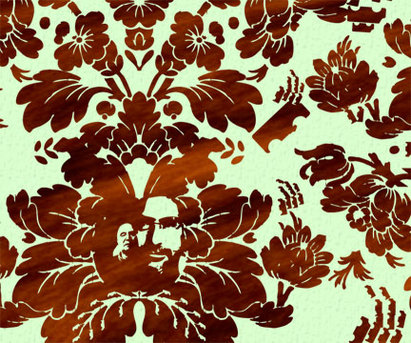
Detail: VAN custom narrative wallpaper, 2007 digital print 8' x 8'
03.02.07
VANGUARD Room
March 2 - 27, 2007
Opening Reception: Friday, March 2nd, 8 - 10:00 pm
Van Atelier North (VAN) brings a series of home décor prototypes to CRAM gallery. Staged as an Ikea-style walk-in environment, VANGUARD Room is a mutant hybrid of hunting-lodge-futurism, William Morris Co, and 70s-den-chic. Pieces include a remote-controlled ottoman, custom digital wallpapers, kitchen items and lighting. Photo-dioramas depicting high-end interiors as car crash sites punctuate the space.
VAN was formed as a partly fictional and nomadic collective of designers and artists. This show features the work of Iain, Andrea, Kyle, and Joep.
VANGUARD Room
March 2 - 27, 2007
Opening Reception: Friday, March 2nd, 8 - 10:00 pm
Van Atelier North (VAN) brings a series of home décor prototypes to CRAM gallery. Staged as an Ikea-style walk-in environment, VANGUARD Room is a mutant hybrid of hunting-lodge-futurism, William Morris Co, and 70s-den-chic. Pieces include a remote-controlled ottoman, custom digital wallpapers, kitchen items and lighting. Photo-dioramas depicting high-end interiors as car crash sites punctuate the space.
VAN was formed as a partly fictional and nomadic collective of designers and artists. This show features the work of Iain, Andrea, Kyle, and Joep.
Dave Gordon
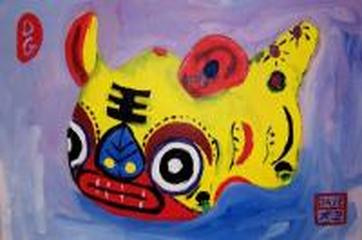
Detail: Chinese Toy #2, acrylic on canvas, 14 in. x 18 in.,2007
04.13.07
Money Cats & Rubber Chickens
April 13 to May 1, 2007
Opening Reception: Friday, April 13th, 8 - 11 PM
On a visit to Ottawa around Chinese New Year 2004 Dave Gordon bought a Chinese Money Cat, never dreaming that a year later, after answering an ad "Teach in Shanghai!", he would be living in the Oz –like megalopolis Shanghai, teaching Jolly Phonics to 5 year old Chinese kids. He did some paintings of the money cat, and also a series of rubber chicken paintings that foreshadow the images of fowl hanging in restaurant windows in Puxi. The rubber chickens might also evoke the threat of bird flu, which was in the news in China and North America last year. After returning to Kingston he made some scrolls - ink on rice paper - incorporating quotes from Lao Tzu, Sun Tzu, and the journal he kept in China.
Dave Gordon (Da Wei) is an artist living and working in Kingston, Ontario. His work is in the collections of the National Gallery of Canada, the Art Gallery of Ontario, The Agnes Etherington Art Centre and the London Art Museum and private collections. He will be showing work at the State of Flux Gallery at Modern Fuel Artist-run Centre in Kingston June 13 – July 7, 2007.
(Da Wei says: Hi Mengni! Hi Shao Peter!)
Money Cats & Rubber Chickens
April 13 to May 1, 2007
Opening Reception: Friday, April 13th, 8 - 11 PM
On a visit to Ottawa around Chinese New Year 2004 Dave Gordon bought a Chinese Money Cat, never dreaming that a year later, after answering an ad "Teach in Shanghai!", he would be living in the Oz –like megalopolis Shanghai, teaching Jolly Phonics to 5 year old Chinese kids. He did some paintings of the money cat, and also a series of rubber chicken paintings that foreshadow the images of fowl hanging in restaurant windows in Puxi. The rubber chickens might also evoke the threat of bird flu, which was in the news in China and North America last year. After returning to Kingston he made some scrolls - ink on rice paper - incorporating quotes from Lao Tzu, Sun Tzu, and the journal he kept in China.
Dave Gordon (Da Wei) is an artist living and working in Kingston, Ontario. His work is in the collections of the National Gallery of Canada, the Art Gallery of Ontario, The Agnes Etherington Art Centre and the London Art Museum and private collections. He will be showing work at the State of Flux Gallery at Modern Fuel Artist-run Centre in Kingston June 13 – July 7, 2007.
(Da Wei says: Hi Mengni! Hi Shao Peter!)
Kevin Richardson & downtowner Tony
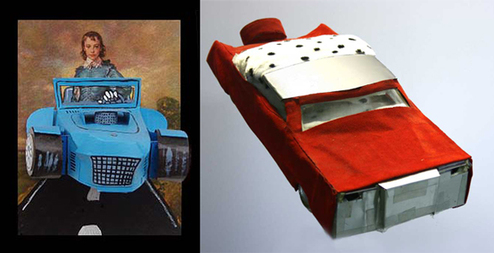
05.04.07
Eldorado Pop
May 4 - 29, 2007
Opening Reception: Friday, May 4th
with something resembling music by the remnants of Attic Daddy
Kevin Richardson is a musician and visual artist who uses recycled materials to create vibrant assemblages and paintings that comment on popular culture with wit and humour.
How does one narrow down the huge glut of information and all the influences thrown in your direction? You absorb until it spills out. Just the heroic, romantic stuff alone will feed a lifetime. Andy Warhol, Gene Vincent, Marcel Duchamp and Shemp Howard hold equal stature.
Tony is a self-described downtowner - it’s a familiar sight to see him walking on St. Catharines’ main drags. Last fall Tony showed up at NAC with a garbage bag and asked if anyone would like to take a look at what he’d been working on. He pulled out a model of a red Cadillac Eldorado about 18 inches long and six inches wide - it’s in the neighbourhood of O scale or 1:48. The caddy is immaculately detailed, complete with a golden continental mounted spare tire--and constructed entirely from scratch from cardboard pizza boxes, beer cans, leather, and fabrics he picked up at the St. Vincent de Paul church. His replicas come in a variety of colours with different hard-top styles and a few convertibles. They are all 1977 Cadillac Eldorados. Tony says, "It’s the car".
Eldorado Pop
May 4 - 29, 2007
Opening Reception: Friday, May 4th
with something resembling music by the remnants of Attic Daddy
Kevin Richardson is a musician and visual artist who uses recycled materials to create vibrant assemblages and paintings that comment on popular culture with wit and humour.
How does one narrow down the huge glut of information and all the influences thrown in your direction? You absorb until it spills out. Just the heroic, romantic stuff alone will feed a lifetime. Andy Warhol, Gene Vincent, Marcel Duchamp and Shemp Howard hold equal stature.
Tony is a self-described downtowner - it’s a familiar sight to see him walking on St. Catharines’ main drags. Last fall Tony showed up at NAC with a garbage bag and asked if anyone would like to take a look at what he’d been working on. He pulled out a model of a red Cadillac Eldorado about 18 inches long and six inches wide - it’s in the neighbourhood of O scale or 1:48. The caddy is immaculately detailed, complete with a golden continental mounted spare tire--and constructed entirely from scratch from cardboard pizza boxes, beer cans, leather, and fabrics he picked up at the St. Vincent de Paul church. His replicas come in a variety of colours with different hard-top styles and a few convertibles. They are all 1977 Cadillac Eldorados. Tony says, "It’s the car".
Pete Wing
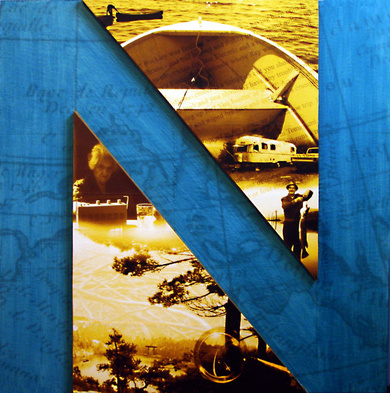
DETAIL - Cardinal Point (North), mixed media, 2 ft x 2 ft, 2007
06.08.07
Cardinal Points
June 8 - 30, 2007
Opening: Friday, June 8th, 8 to 11 pm
Even though we’re constantly diverted from our path by the unexpected, still we gather ourselves together in moments of calm and pull out a compass, moral or otherwise, in an attempt to get our bearings and continue the journey.
The works in this exhibition reflect a compass reading of my journey at this moment in time, a survey of the four cardinal directions from a centre point, encompassing past and present, the personal and the impersonal, the spiritual and the worldly
Peter Wing is a writer and artist living and working in Port Dalhousie. He joined the Niagara Artists Company in 1979, is the founding Director of the Niagara Artists Centre, and served on the Board of Directors for seven years. In the past he has shown his works in individual and group exhibitions and is represented in various private collections. He has worked for many years as an Art Director in film production, art publications, and magazines and is currently working on two novels and short stories. Although he has been writing, he has recently returned to making visual art.
Cardinal Points
June 8 - 30, 2007
Opening: Friday, June 8th, 8 to 11 pm
Even though we’re constantly diverted from our path by the unexpected, still we gather ourselves together in moments of calm and pull out a compass, moral or otherwise, in an attempt to get our bearings and continue the journey.
The works in this exhibition reflect a compass reading of my journey at this moment in time, a survey of the four cardinal directions from a centre point, encompassing past and present, the personal and the impersonal, the spiritual and the worldly
Peter Wing is a writer and artist living and working in Port Dalhousie. He joined the Niagara Artists Company in 1979, is the founding Director of the Niagara Artists Centre, and served on the Board of Directors for seven years. In the past he has shown his works in individual and group exhibitions and is represented in various private collections. He has worked for many years as an Art Director in film production, art publications, and magazines and is currently working on two novels and short stories. Although he has been writing, he has recently returned to making visual art.
Tobey C. Anderson
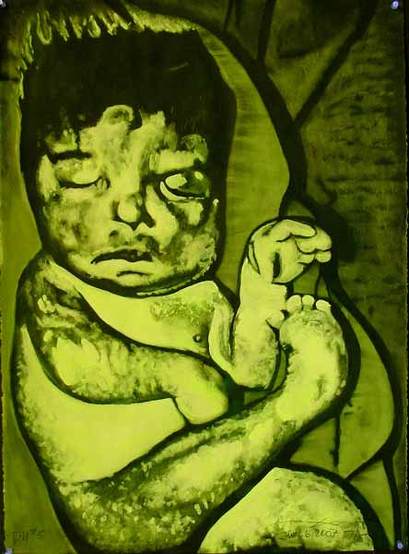
DU Babies_01, mixed media, on paper, 22 in x 30 in, 2007
09.07.07
DU Babies
The New American Century Project - Chapter 7
September 7 - 25, 2007
In this suite of seven mixed media florescent drawings, Anderson exposes and explores the brutal and grim effects that Depleted Uranium has on the developing foetus through the subsequent physical manifestations in the children born of Iraqis who have been exposed to the radiation of current high tech warfare. Illuminated under black lights, these images radiate the eerie glow that is the hallmark of The New American Century Project installations, an allusion to the radiation as well as the computer screen where the images were appropriated from the Internet.
Not typical of traditional War Art and under the radar in the public mind, this issue brings the reality that Nuclear Warfare is being conducted by any country using Depleted Uranium ordinance. Used to harden the tips of high calibre munitions and smart bombs, Depleted Uranium is pulverized on impact and contaminates the air and area around the impact sites. Canada has these munitions in its arsenal, like the United States and Britain.
Since the first Gulf War thousands of Iraqi citizens, as well as Coalition and UN troops, have been exposed to the radiation left behind following bombardments, strafing, and fire fights, and unknown numbers of infants are being born deformed in war zones and back home when troops return contaminated.
tobeycanderson.com
The artist gratefully acknowledges the assistance of the Ontario Arts Council - Mid Career Artist Grant Program
DU Babies
The New American Century Project - Chapter 7
September 7 - 25, 2007
In this suite of seven mixed media florescent drawings, Anderson exposes and explores the brutal and grim effects that Depleted Uranium has on the developing foetus through the subsequent physical manifestations in the children born of Iraqis who have been exposed to the radiation of current high tech warfare. Illuminated under black lights, these images radiate the eerie glow that is the hallmark of The New American Century Project installations, an allusion to the radiation as well as the computer screen where the images were appropriated from the Internet.
Not typical of traditional War Art and under the radar in the public mind, this issue brings the reality that Nuclear Warfare is being conducted by any country using Depleted Uranium ordinance. Used to harden the tips of high calibre munitions and smart bombs, Depleted Uranium is pulverized on impact and contaminates the air and area around the impact sites. Canada has these munitions in its arsenal, like the United States and Britain.
Since the first Gulf War thousands of Iraqi citizens, as well as Coalition and UN troops, have been exposed to the radiation left behind following bombardments, strafing, and fire fights, and unknown numbers of infants are being born deformed in war zones and back home when troops return contaminated.
tobeycanderson.com
The artist gratefully acknowledges the assistance of the Ontario Arts Council - Mid Career Artist Grant Program
Marinko Jareb
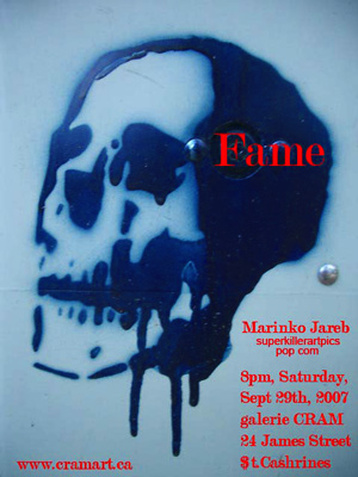
09.29.07
One Nite Only
Saturday • Sept 29
music by dj phonography & the trendsetting cassette tapes
This new collection of artwork by Marinko is comprised of painting, collage, sculpture and carvings. FAME is Marinko's attempt to make work that will last for generations to come by using "permanent" materials like rock and steel as well as the usual, one-of-a-kind works on canvas and paper (to make your apartment or home look unique).
Marinko Jareb is a multidisciplinary artist who splits his time between St.Catharines and Toronto. Marinko's work can be characterized by a collage aesthetic in works on paper and canvas, and audio & video. Marinko's work was featured on a FUSE cover and article about appropriation art. Marinko is very interested in the freedom of expression and democracy inherent in street art. Marinko also values garbage and discarded materials.
In addition to being a member of the CRAM Collective, Marinko is a member and volunteer at NAC, a member of The Vinyl Interventions Trio (www.vinylinterventions.com), and a Founder of Smoke Gallery in Downtown Niagara Falls. Marinko is represented in Canada by CRAM and Europe & Asia by Editions Sahko Linna, Helsinki.
One Nite Only
Saturday • Sept 29
music by dj phonography & the trendsetting cassette tapes
This new collection of artwork by Marinko is comprised of painting, collage, sculpture and carvings. FAME is Marinko's attempt to make work that will last for generations to come by using "permanent" materials like rock and steel as well as the usual, one-of-a-kind works on canvas and paper (to make your apartment or home look unique).
Marinko Jareb is a multidisciplinary artist who splits his time between St.Catharines and Toronto. Marinko's work can be characterized by a collage aesthetic in works on paper and canvas, and audio & video. Marinko's work was featured on a FUSE cover and article about appropriation art. Marinko is very interested in the freedom of expression and democracy inherent in street art. Marinko also values garbage and discarded materials.
In addition to being a member of the CRAM Collective, Marinko is a member and volunteer at NAC, a member of The Vinyl Interventions Trio (www.vinylinterventions.com), and a Founder of Smoke Gallery in Downtown Niagara Falls. Marinko is represented in Canada by CRAM and Europe & Asia by Editions Sahko Linna, Helsinki.
John Moffat
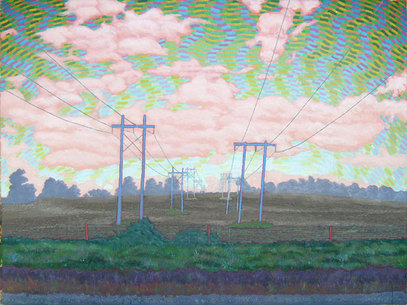
Towards Bewdley, acrylic on paper, 58.5 x 76.2 cm (23" x 30"), 2007
10.12.07
Lines of Intent
October 12 - 30, 2007
Before moving to Cavan, Ontario, I had lived in downtown St. Catharines and most of my paintings were of the surrounding cityscape. These works brought together the interests I had in history, urban culture and science. My images juxtaposed the old with the new and placed them under a pulsating sky. I likened that to peeling away the colloidal effect of the atmosphere revealing the ionospheres dance with the earth - present, but invisible to us.
When I moved to an old farmhouse in Cavan township near Peterborough, all the patterns of history and human settlement that had been clear in the city was subtler in the country. It took me a couple of years to interpret what I saw and translate it into my paintings.
A hydro pylon corridor that ran through the back of the farm became the center of my interest for a large number of my works. These large, almost invisible, modern-day totems connect all of us but alienate us from each other. Our easy acceptance of their presence in the landscape is what I have tried to explore in my Cavan paintings. Also being in the countryside allowed me to follow the patterns of plowing and planting the crops so that over the six years on the farm the landscape was constantly changing. I never got tired of painting my "own backyard".
My next move was to Ottawa where I continued my interest of the altered landscape. Perth Ontario is now my home, but the images that interest me now are gleaned from my travels. My "backyard" has gotten larger. I am still interpreting the patterns of landscape moulded by human industry, economy, carelessness and neglect...In my paintings it is a better world.
John Moffat, October 2007
Lines of Intent
October 12 - 30, 2007
Before moving to Cavan, Ontario, I had lived in downtown St. Catharines and most of my paintings were of the surrounding cityscape. These works brought together the interests I had in history, urban culture and science. My images juxtaposed the old with the new and placed them under a pulsating sky. I likened that to peeling away the colloidal effect of the atmosphere revealing the ionospheres dance with the earth - present, but invisible to us.
When I moved to an old farmhouse in Cavan township near Peterborough, all the patterns of history and human settlement that had been clear in the city was subtler in the country. It took me a couple of years to interpret what I saw and translate it into my paintings.
A hydro pylon corridor that ran through the back of the farm became the center of my interest for a large number of my works. These large, almost invisible, modern-day totems connect all of us but alienate us from each other. Our easy acceptance of their presence in the landscape is what I have tried to explore in my Cavan paintings. Also being in the countryside allowed me to follow the patterns of plowing and planting the crops so that over the six years on the farm the landscape was constantly changing. I never got tired of painting my "own backyard".
My next move was to Ottawa where I continued my interest of the altered landscape. Perth Ontario is now my home, but the images that interest me now are gleaned from my travels. My "backyard" has gotten larger. I am still interpreting the patterns of landscape moulded by human industry, economy, carelessness and neglect...In my paintings it is a better world.
John Moffat, October 2007
John B. Boyle, RCA
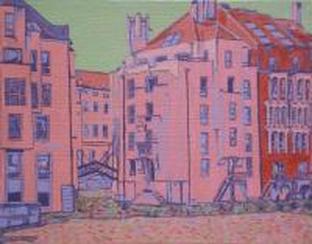
oil on canvas, 10"w. x 8"h, 2007
11.09.12
Journées à Metz
November 9 - 27, 2007
Opening Reception: Friday Nov 9
Journées à Metz is an exhibition of eight small paintings and one large format portrait. In the Spring of 2007 Boyle and Aya Onishi lived for two months in the apartment of a friend in the ancient city of Metz in the east of France near the German border. On returning to Canada, Boyle re-read his late friend Dennis Tourbin's 1980 limited edition journal Journées à Paris. Having visited Tourbin in his Paris studio at the time, participated with him in exhibitions and performances there and shared many wonderful memories, Boyle was inspired to dedicate this little exhibition to his friend and their shared French experience separated by twenty-seven years.
John B, Boyle was born in London, Ontario. He lived in St. Catharines from 1962 until 1975, where he taught elementary school before becoming a full time visual artist in 1968. His works are represented in the collections of the National Gallery of Canada, the Musee des Beaux Arts in Montreal, the Art Gallery of Ontario, the Vancouver Art Gallery, and most major public and corporate collections in Canada. He has exhibited widely internationally, including the Musee d'Art Moderne, Paris, Musee des Beaux Arts, Liege, Musee des Beaux Arts, Mons, Pavillon des Arts, Parc Vincennes, Paris, Cafe Gallery, London, U.K., Fukugan Gallery, and The Bridge, Osaka. He is the founding president, Niagara Artists' Centre, founding Spokesperson, Canadian Artists' Representation, Ontario, past director, Canadian Centre of the Arts at Owen Sound, and has sat on the Board of Trustees, Art Gallery of Ontario and the McMichael Canadian Art Collection, and on the Canada Council Advisory Arts Panel. He is represented by the Loch Gallery, Toronto and Fukugan Gallery, Osaka. Boyle is an elected member of the Royal Canadian Academy and a proud member of the CRAM collective.
baYal
baYal is the noise/musical unit of John Boyle and Aya Onishi. Boyle has played in the legendary noise band the Nihilist Spasm Band since 1965. Ridiculed for decades in Canada as a band of incompetents or a « joke carried too far », the NSB are now generally recognized as the world's first noise band and the founders of a new genre of music celebrated in festivals around the world. Aya Onishi, as the then manager of Osaka's Alchemy records helped organize two Japanese NSB tours in the 1990's and the release of six NSB records. A drummer herself in the all woman band Sekiri, she has sat in frequently with the NSB since 1996. In baYal, Onishi plays drums and kazoo, and Boyle plays kazoo, drums, thumb piano, and ring modulator. BaYal have performed at The Bridge, Osaka; Uplink Factory, Tokyo; Kunstencentrum, Hasselt, Belgium; Sonic Protest, Paris, and at various venues in Canada. They will give a fifteen minute performance at the CRAM opening, November 9, 2007.
*CRAM events catered by The Office restaurant
Journées à Metz
November 9 - 27, 2007
Opening Reception: Friday Nov 9
Journées à Metz is an exhibition of eight small paintings and one large format portrait. In the Spring of 2007 Boyle and Aya Onishi lived for two months in the apartment of a friend in the ancient city of Metz in the east of France near the German border. On returning to Canada, Boyle re-read his late friend Dennis Tourbin's 1980 limited edition journal Journées à Paris. Having visited Tourbin in his Paris studio at the time, participated with him in exhibitions and performances there and shared many wonderful memories, Boyle was inspired to dedicate this little exhibition to his friend and their shared French experience separated by twenty-seven years.
John B, Boyle was born in London, Ontario. He lived in St. Catharines from 1962 until 1975, where he taught elementary school before becoming a full time visual artist in 1968. His works are represented in the collections of the National Gallery of Canada, the Musee des Beaux Arts in Montreal, the Art Gallery of Ontario, the Vancouver Art Gallery, and most major public and corporate collections in Canada. He has exhibited widely internationally, including the Musee d'Art Moderne, Paris, Musee des Beaux Arts, Liege, Musee des Beaux Arts, Mons, Pavillon des Arts, Parc Vincennes, Paris, Cafe Gallery, London, U.K., Fukugan Gallery, and The Bridge, Osaka. He is the founding president, Niagara Artists' Centre, founding Spokesperson, Canadian Artists' Representation, Ontario, past director, Canadian Centre of the Arts at Owen Sound, and has sat on the Board of Trustees, Art Gallery of Ontario and the McMichael Canadian Art Collection, and on the Canada Council Advisory Arts Panel. He is represented by the Loch Gallery, Toronto and Fukugan Gallery, Osaka. Boyle is an elected member of the Royal Canadian Academy and a proud member of the CRAM collective.
baYal
baYal is the noise/musical unit of John Boyle and Aya Onishi. Boyle has played in the legendary noise band the Nihilist Spasm Band since 1965. Ridiculed for decades in Canada as a band of incompetents or a « joke carried too far », the NSB are now generally recognized as the world's first noise band and the founders of a new genre of music celebrated in festivals around the world. Aya Onishi, as the then manager of Osaka's Alchemy records helped organize two Japanese NSB tours in the 1990's and the release of six NSB records. A drummer herself in the all woman band Sekiri, she has sat in frequently with the NSB since 1996. In baYal, Onishi plays drums and kazoo, and Boyle plays kazoo, drums, thumb piano, and ring modulator. BaYal have performed at The Bridge, Osaka; Uplink Factory, Tokyo; Kunstencentrum, Hasselt, Belgium; Sonic Protest, Paris, and at various venues in Canada. They will give a fifteen minute performance at the CRAM opening, November 9, 2007.
*CRAM events catered by The Office restaurant
Sandy Fairbairn
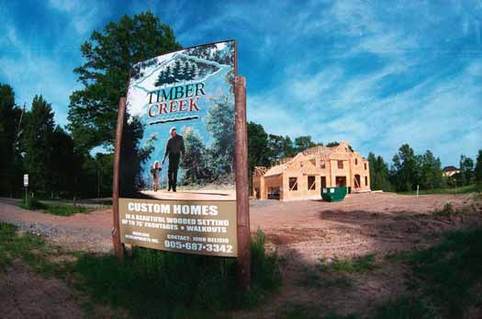
"Timber Creek", photograph
12.07.07
New Photographs
December 7, 2007 to January 1, 2008
Opening Reception: Friday, Dec 7th
Most of the images in this exhibition depict the artists, colleagues, comrades, associates, sustainers, supporters, patrons, hangers-on, CRAM Junkies, and friends of art who fuel the art scene in St. Catharines, making it dynamic and enduring. Stepping away from his usual manner of working and subject matter, for over a year Fairbairn has photographed The Scene and the people who keep it on track. The Scene also includes a few photographs of machines, buildings, change and objects of decay.
New Photographs
December 7, 2007 to January 1, 2008
Opening Reception: Friday, Dec 7th
Most of the images in this exhibition depict the artists, colleagues, comrades, associates, sustainers, supporters, patrons, hangers-on, CRAM Junkies, and friends of art who fuel the art scene in St. Catharines, making it dynamic and enduring. Stepping away from his usual manner of working and subject matter, for over a year Fairbairn has photographed The Scene and the people who keep it on track. The Scene also includes a few photographs of machines, buildings, change and objects of decay.
